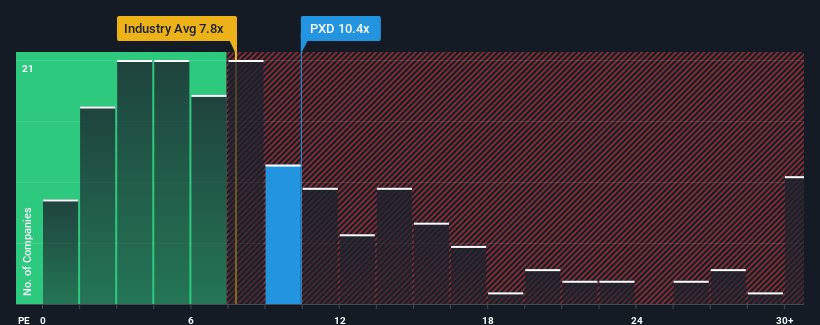- United States
- /
- Oil and Gas
- /
- NYSE:PXD
Lacklustre Performance Is Driving Pioneer Natural Resources Company's (NYSE:PXD) Low P/E

With a price-to-earnings (or "P/E") ratio of 10.4x Pioneer Natural Resources Company (NYSE:PXD) may be sending bullish signals at the moment, given that almost half of all companies in the United States have P/E ratios greater than 18x and even P/E's higher than 33x are not unusual. Although, it's not wise to just take the P/E at face value as there may be an explanation why it's limited.
Pioneer Natural Resources has been struggling lately as its earnings have declined faster than most other companies. It seems that many are expecting the dismal earnings performance to persist, which has repressed the P/E. If you still like the company, you'd want its earnings trajectory to turn around before making any decisions. If not, then existing shareholders will probably struggle to get excited about the future direction of the share price.
View our latest analysis for Pioneer Natural Resources

Does Growth Match The Low P/E?
There's an inherent assumption that a company should underperform the market for P/E ratios like Pioneer Natural Resources' to be considered reasonable.
Retrospectively, the last year delivered a frustrating 26% decrease to the company's bottom line. Still, the latest three year period has seen an excellent 2,972% overall rise in EPS, in spite of its unsatisfying short-term performance. So we can start by confirming that the company has generally done a very good job of growing earnings over that time, even though it had some hiccups along the way.
Turning to the outlook, the next three years should generate growth of 1.0% per annum as estimated by the analysts watching the company. That's shaping up to be materially lower than the 12% each year growth forecast for the broader market.
In light of this, it's understandable that Pioneer Natural Resources' P/E sits below the majority of other companies. Apparently many shareholders weren't comfortable holding on while the company is potentially eyeing a less prosperous future.
The Key Takeaway
While the price-to-earnings ratio shouldn't be the defining factor in whether you buy a stock or not, it's quite a capable barometer of earnings expectations.
We've established that Pioneer Natural Resources maintains its low P/E on the weakness of its forecast growth being lower than the wider market, as expected. At this stage investors feel the potential for an improvement in earnings isn't great enough to justify a higher P/E ratio. Unless these conditions improve, they will continue to form a barrier for the share price around these levels.
It is also worth noting that we have found 3 warning signs for Pioneer Natural Resources (1 doesn't sit too well with us!) that you need to take into consideration.
If these risks are making you reconsider your opinion on Pioneer Natural Resources, explore our interactive list of high quality stocks to get an idea of what else is out there.
New: Manage All Your Stock Portfolios in One Place
We've created the ultimate portfolio companion for stock investors, and it's free.
• Connect an unlimited number of Portfolios and see your total in one currency
• Be alerted to new Warning Signs or Risks via email or mobile
• Track the Fair Value of your stocks
Have feedback on this article? Concerned about the content? Get in touch with us directly. Alternatively, email editorial-team (at) simplywallst.com.
This article by Simply Wall St is general in nature. We provide commentary based on historical data and analyst forecasts only using an unbiased methodology and our articles are not intended to be financial advice. It does not constitute a recommendation to buy or sell any stock, and does not take account of your objectives, or your financial situation. We aim to bring you long-term focused analysis driven by fundamental data. Note that our analysis may not factor in the latest price-sensitive company announcements or qualitative material. Simply Wall St has no position in any stocks mentioned.
About NYSE:PXD
Pioneer Natural Resources
Pioneer Natural Resources Company operates as an independent oil and gas exploration and production company in the United States.
Average dividend payer with acceptable track record.


